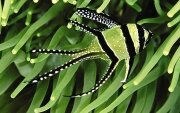Aquarium Science to the Rescue
From Microcosm Aquarium Explorer
THE AQUARIUM ECOLOGIST

By John Tullock
December 10, 2007
A gloomy, rainy December day envelopes the Tennessee Valley as I write this. After the driest summer ever recorded, the warmest winter appears headed my way. The temptation to blame this on climate change looms large in my mind. I’ll leave it to the meteorologists to decide if global warming is responsible for the weather this year, but it sure is warmer than when I was a boy, five decades ago.
Whether my wilted summer garden resulted from climate change or not, the atmospheric events of 2007 serve as a reminder that human beings can and do affect the environment in profound ways. The focus of my essays in this space will be the aquatic environments of reef, rainforest and river and the life contained within them. We must never overlook the fact that all habitats are interconnected, especially aquatic habitats. The rain falling on my lawn in Tennessee will find its way to the Gulf of Mexico, carrying with it in effect a chemical and biological sample of the surfaces over which it flows, adding these finally to the vast melting pot of the Mississippi, and eventually the sea.
The science of ecology recognizes that all life on the planet is interconnected at some level. The scientific laws at work in one place on Earth are equally in force elsewhere. Do not be alarmed, therefore, as I seemingly leap from one side of the globe to another in seeking out examples to make a single point: The art and science of creating and observing captive microcosms in aquariums, terrariums, and vivariums not only is capable of revealing facts about living organisms obtainable in no other way, but also these technologies open the door to the means to ameliorate, and even reverse, at least some of the damage inflicted by human activities on aquatic ecosystems over the past 150 years.
[edit] A Solution in Captive Breeding?
Consider for a moment the Banggai Cardinalfish (Pterapogon kauderni). It will be familiar to marine aquarium enthusiasts, both as a superbly beautiful subject for a moderately-sized aquarium, and as having been proposed for CITES listing (and possible collection bans), unsuccessfully, during the summer of 2007.

Some research indicates collecting for the aquarium trade has reduced the Banggai Cardinalfish population by 90 percent in little more than a decade of unregulated harvest. On the other hand, this species ironically poses few challenges to captive propagation. It is a mouthbrooder, producing relatively enormous larvae that are easily reared on widely available foods. The Indonesian government, within whose territory the only known populations of P. kauderni exist, pointed to the potential of aquaculture as one reason against a CITES listing.
The case of the Banggai cardinalfish is but one of the many I hope to explore in this blog. For this rare and beautiful species, and many others like it, the efforts of aquarium hobbyists and professionals can provide genuine hope. Species disappear rapidly, almost always due to the way human beings apply our technology.
My hope is to create a new dialogue about how aquarium technology can solve, rather than create, problems of biodiversity preservation in reefs, rainforests, and rivers. Some of these locales will be exotic; some will be within a short drive from your home. All harbor examples of Darwin’s “wondrous forms most beautiful.”
I hope you will join me often to explore these places, the intriguing life they contain, and how some of those life forms can delight and instruct us when maintained in captivity.
[edit] Comments?
Microcosm Aquarium Explorer invites correspondence from its readers.
For publication, a letter should include the writer's name, hometown, state/province, and country.
Please send to: [email protected]
John Tullock is a marine zoologist, author and consultant. His enormously popular Natural Reef Aquariums and numerous other books and articles, have focused upon the aquarium hobby and industry for two decades.
References:








